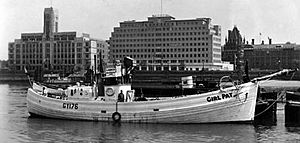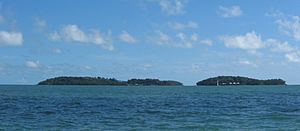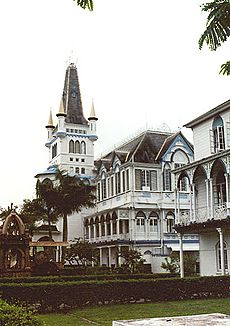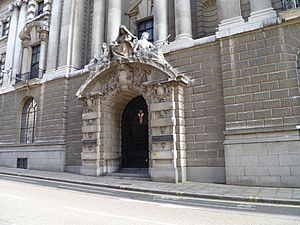Girl Pat facts for kids
class="infobox " style="float: right; clear: right; width: 315px; border-spacing: 2px; text-align: left; font-size: 90%;"
| colspan="2" style="text-align: center; font-size: 90%; line-height: 1.5em;" |
|}
The Girl Pat was a small fishing trawler from Grimsby, England. In 1936, it became famous for an amazing adventure. Its captain, George "Dod" Orsborne, took the boat on a long trip across the Atlantic Ocean without permission.
The journey ended in Georgetown, British Guiana (now Guyana). Orsborne and his brother were arrested there. They were later sent to prison for taking the boat without permission.
The Girl Pat was built in 1935. It belonged to the Marstrand Fishing Company. On April 1, 1936, Orsborne and his crew of four, plus his brother James, set off. The owners thought they were going on a normal fishing trip in the North Sea for a few weeks.
But after leaving port, Orsborne told his crew they were going on a much longer journey. No one heard from them until mid-May. The owners thought the boat was lost. Then, they received bills for repairs and supplies from Corcubión, a port in Spain.
Later, the Girl Pat was seen in the Savage Islands, then in Dakar, Senegal. It was also spotted near Îles du Salut in South America. Captain Orsborne used only a cheap school atlas and a compass to navigate over 6,000 nautical miles. At one point, news even said the Girl Pat had sunk in the Bahamas. But the boat was found and stopped near Georgetown on June 19. Orsborne and his crew became heroes in newspapers around the world.
After prison, Orsborne had more adventures at sea. He also served in the navy during World War II. He passed away in 1957. The Girl Pat was bought by new owners in Georgetown. They brought it back to Britain. It was shown as a tourist attraction in several towns. In 1939, the Port of London Authority bought it. They used it to mark shipwrecks. The Royal Navy used it during the war. In 1945, it went back to the Port of London Authority. What happened to it after that is not publicly known.
Contents
| History | |
|---|---|
| United Kingdom | |
| Name |
|
| Owner |
|
| Port of registry |
|
| Builder | at Oulton Broad |
| In service | 1935 |
| Identification |
|
| General characteristics | |
| Type |
|
| Tonnage | 55 GRT, 19 NRT |
| Length | 66 feet (20 m) |
| Beam | 18.7 feet (5.7 m) |
| Depth | 8.7 feet (2.7 m) |
| Installed power | 120 bhp |
The Captain and Crew
Meet Dod Orsborne
George Black Orsborne was born on July 4, 1902, in Buckie, Scotland. He took the name Orsborne when his mother remarried. When he was 14, he joined the Royal Navy by saying he was older. He served in the Dover Patrol.
After leaving the Navy, he worked on land for a short time. But he was convinced to go back to sea. He joined the merchant navy, working on small ships. At 21, he became a captain of a trawler. For ten years, Orsborne had many sea adventures. In November 1935, he became the skipper of the Gipsy Love. This boat was owned by the Marstrand Fishing Company.
The Crew and the Ship
In March 1936, Orsborne planned another trip on the Gipsy Love. He told a sailor named Alexander MacLean that the trip might go far, maybe to Bermuda or South America. MacLean said no. So, Orsborne asked Harry Stone to be the mate. The other crew members were Hector Harris and 17-year-old Howard Stephen, the cook. Orsborne's younger brother, James, also joined them. He was a grocer and had no official role on board.
The Gipsy Love left Grimsby in late March 1936. It was supposed to fish in the Dogger Bank area. But it quickly returned to port with engine problems. Orsborne moved the crew and supplies to another Marstrand boat, the Girl Pat. James Orsborne joined them again.
The Girl Pat was built in 1935 in Oulton Broad, Suffolk. It was 66 feet (20 meters) long and could hold six people. It was insured for £3,000. The ship's regular engineer, George Jefferson, also joined Orsborne's crew for this trip.
The Amazing Journey Begins
From Grimsby to Spain
The Girl Pat left Grimsby on April 1, 1936. Harry Stone later said that once they were at sea, Orsborne gathered the crew. He told them this would not be a normal fishing trip. He planned to take the boat south. First, they would stop in Dover to drop off Jefferson. Orsborne was not sure about his long-term plans yet. But he said they would sail to warmer waters and might even look for pearls.
On April 3, the boat reached Dover. Jefferson went ashore. When he came back, the Girl Pat was gone. He was confused and returned to Grimsby. As the Girl Pat sailed into the English Channel, Orsborne told his crew they had no proper maps. They would use a cheap school atlas for navigation. He changed names in the boat's log book. He became "G. Black," Stone became "H. Clark," and James Orsborne became "A. Black."
After waiting in Jersey for better weather, the Girl Pat sailed south through the Bay of Biscay. Orsborne changed the boat's look. He changed the bowsprit and painted over the fishing number on the side. Stone said Orsborne planned to visit Madeira, the Canary Islands, and the African coast. He even mentioned Cape Town. They might sell the boat and share the money.
Bad weather hit the small boat in the Bay of Biscay. So, on April 12, they stopped in the Spanish port of Corcubión. They stayed for about two weeks. They made repairs and got more supplies. Orsborne told them to send the bills, totaling £235, to Marstrand's in Grimsby. He said it was their punishment for sending the boat out with not enough supplies.
After Jefferson returned, Marstrand's was confused. They thought Orsborne had hired another engineer and was just fishing in new areas. There were unconfirmed sightings of the Girl Pat in other places. Weeks passed with no news. The owners thought the boat was lost and claimed insurance money. They had already received £2,400. Then, they were surprised by the bills from Corcubión. They also heard that the Girl Pat had left on April 24, destination unknown.
From Spain to Africa
After leaving Corcubión, people thought Orsborne might fish near Gibraltar. But the boat was not seen there. Stone remembered they reached some empty islands. This matches a sighting by a British ship, the SS Avoceta. On May 17, it saw a boat like the trawler anchored in the Savage Islands. These small islands are south of Madeira. They were known for pirate treasure stories. News of the Girl Pat being there made newspapers wonder if they were hunting for treasure.
Meanwhile, the Girl Pat secretly stopped at Tenerife in the Canary Islands. There, it was repainted. Leaving Tenerife, the Girl Pat continued south along the African coast. Stone said the crew went ashore at Port Etienne (now Nouadhibou, Mauritania). While they were away, thieves stole gear and food. The crew had almost nothing left to eat or drink.
Leaving Port Etienne, they got stuck on a sandbank for three days. They finally got free. On May 23, a pilot boat brought them into Dakar harbour. They were hungry and tired. Stone got sick with appendicitis and was taken to the hospital in Dakar. He did not continue the journey. Orsborne got more fuel and water. But the Girl Pat's arrival caught the eye of a local agent. On May 26, he saw Orsborne and checked the log book. He found the fake names and other odd things. Orsborne was asked to show the ship's papers at the British consulate. But he quickly sailed away, saying he needed to test the engines.
The news of the Girl Pat in Dakar was big. It was the first time anyone knew for sure the boat was still sailing since Spain. The families of the crew were relieved they were safe.
Across the Atlantic to Guyana
The story of the Girl Pat was so popular that a movie company thought about making a film. On June 2, a French ship saw a small boat, flying the British flag, sailing south near the Bissagos Islands. People thought it was the Girl Pat. But the next sighting, on June 9, was over 2,000 nautical miles to the west, across the Atlantic Ocean.
Captain Jones of an American ship, the Lorraine Cross, sent a message to agents in Georgetown, British Guiana. He saw a small ship flying a distress signal near the South American coast. It had four men. The boat's name was painted over, but it claimed to be the "Margaret Harold" going to Trinidad. Jones thought the crew acted strangely. When he asked to see the ship's papers, the boat lowered its signal and sped away. Jones said it was "undoubtedly a British fisherman" and thought it was the Girl Pat. In Grimsby, the owners were not surprised. They said the ship was fast enough to cross the ocean. There was no registered ship named Margaret Harold.
A report from the Îles du Salut, near French Guiana, said a boat like the Girl Pat got water there on June 10. An airplane searched over 1,000 miles of coastline near Georgetown but did not find the boat. On June 17, some newspapers reported finding a small boat wreck and three bodies in the Bahamas. Many thought it was the Girl Pat. One headline asked, "Did School Atlas Course Lead Crew to Death?". But these reports were false. Early on June 19, a police boat towed the Girl Pat into Georgetown harbour.
Caught and Arrested
On the evening of June 18, a British ship, the Arakaka, saw a small boat near Georgetown. It radioed the police. An unarmed police boat went to check. As they got close, the crew of the unknown boat became unfriendly. They said it was not the Girl Pat and threatened violence if officers tried to board. The police boat went back to Georgetown. The officers got weapons and permission to seize the boat. They returned early the next morning. The boat was leaving.
A two-hour chase began. Newspapers made it sound like an exciting race. The faster police boat chased the fleeing boat. Finally, the boats crashed while turning close to each other. The back of the suspect boat was badly damaged. It then gave up and was towed. The name on the boat was "Kia-ora." But Stephens quickly told their captors that the ship was the Girl Pat.
The Girl Pat was secured in Georgetown harbour. The Orsborne brothers, Harris, and Stephens were taken to police headquarters. The police said the four were there "at their own request" and were not held. In London, officials were confused about the legal situation. Meanwhile, Orsborne and his friends were seen as heroes. A German newspaper asked if this was "a bit of British tradition, to do the unconventional out of love for adventure." A man from Hull said the adventure showed "the spirit of Drake." He called for people to donate money to help the crew with their debts. Others wondered if the men should be seen as heroes or just as "men who have run away with someone else's property."
Once released by the police, Harris and Stephens went back to England. They arrived on July 13. The Orsborne brothers stayed in Georgetown. George Orsborne told the press he wanted to go home. He said he had many job offers. On June 27, the brothers were arrested. They were charged with taking the Girl Pat without permission.
Court and Prison
In Georgetown Court
The brothers were held in custody. On July 4, they were kept for another week. They were not allowed bail. The brothers said they would go back to England right away. But they were still held. On July 22, their court hearings in Georgetown began. The Girl Pat was formally identified. On July 24, the court ordered the brothers to be sent to England for trial. This needed the approval of the governor, Sir Geoffry Northcote. The governor took his time. The Orsbornes finally left Georgetown on August 13. They boarded a cargo ship called the SS Inanda.
While the Orsbornes were in Georgetown, Harold Stone, the former mate, made his way home from Dakar. He arrived in Liverpool on July 20. After talking to the police, Stone told the press about the hard times during the Girl Pat voyage. He spoke about not having enough food and water. He said he would not want to go through it again. He confirmed they used a school atlas but also had a compass.
London Court Hearings
On September 2, the Inanda docked in England. The brothers were driven to London for a court appearance. They were charged with taking the boat and planning it. The judge allowed each brother to be released on bail for £500. They also had to give up their passports.
When the hearing continued on September 10, the court heard from the owner's director. He said George Orsborne was not allowed to take the Girl Pat outside the North Sea. Stone said Orsborne had planned to take the boat south from the start. He also spoke about the changes to the ship's log. The court heard from Jefferson and other witnesses. The brothers said they were not guilty. They were sent for trial at the Old Bailey. Before the trial, the Girl Pat was sold.
The Old Bailey Trial
The trial at the Old Bailey began on October 19, 1936. The prosecutor said this was not a fun adventure. It was a serious breach of trust by George Orsborne. The goal of the trip was not to help the owners, but to make money for the brothers.
George Orsborne said he had not agreed to the owner's idea to "lose" the boat. He said he was still unsure what to do after leaving with the Girl Pat. Orsborne said that while in Jersey, he told the crew they "may as well make a holiday of it." He then suggested they sail around the Atlantic Ocean before returning to Grimsby. He said there was no plan to steal the boat. They would "thank the owners for the loan of the ship" and return it. Orsborne also said he was offered money for the Girl Pat in Corcubión but turned it down. He denied trying to hide his or the boat's identity in Dakar or leaving to avoid questions. He said the sudden departure was due to problems with local people. He also denied trying to avoid the police in Georgetown. He said his actions were to keep his boat safe from the police launch.
James Orsborne said his brother told him about the owner's idea to get rid of the boat. He told George it would be "a darned fool" idea. He stayed with his brother because he thought he might stop him from doing anything crazy.
In his final speech, the defense lawyer said the main question was if the Orsborne brothers planned to keep the boat forever. He said the evidence suggested a "joy-ride half-way round the world" more than theft. The prosecutor argued that if it was just a joy-ride, why were there false claims about insurance fraud? The judge said it was wrong that the Orsbornes were getting money from newspapers for their story. He said, "Whether the two prisoners be guilty or innocent, the property of someone else was being used by them without permission... George Orsborne clearly knew that he was acting directly against his employer's interests." The jury took only 35 minutes to find both brothers guilty. On October 22, George Orsborne was sentenced to 18 months in prison. James was sentenced to 12 months.
What Happened Next
After the trial, many people still felt sympathy for the Orsborne brothers. One newspaper said the adventure "had given romantic satisfaction to the whole world" and that the captain had become a national hero.
While in prison, George Orsborne put his name to a book about the Girl Pat adventure. It repeated the claim that the boat was sent out without enough supplies. The owners sued the publishers and two newspapers that repeated these details. After his release, Orsborne planned to sail across the Atlantic alone in a small boat. But the trip was delayed and then cancelled when World War II began.
During the war, Orsborne worked on a trawler. He later rejoined the Royal Navy. He was involved in the Normandy landings in June 1944. He also served in the Far East. In September 1947, Orsborne was rescued in the middle of the Atlantic from an abandoned boat. George Orsborne passed away on December 23, 1957, while delivering a boat from Nice to England.
George Orsborne wrote in his 1949 book that Stephens went back to sea. Harris spent his share of the newspaper money. Stone moved to Australia. James Orsborne worked in the Mediterranean helping refugees. Later, he went to Canada. He was in Singapore when it fell to the Japanese in February 1942. He was not heard from again.
The Ship's Later Life
The Girl Pat was repaired in Georgetown by its new owners. It was brought back to England. It arrived in Portsmouth on May 9, 1937. It stayed there for two weeks as a tourist attraction. Then it moved to London. The new owners were not sure about the ship's long-term future. But for a while, it was shown at holiday resorts. On February 17, 1939, The Times reported that the Girl Pat was sold to the Port of London Authority (PLA). It would be used to mark shipwrecks.
After World War II started in September 1939, the navy took the Girl Pat for military use. It was listed as a "minor war vessel" in July 1940. By 1945, it was returned to the PLA. There are no public records of what happened to it after that. The name Girl Pat was used for at least one other ship later. In August 1966, a yacht with that name was stopped by Greek coastguards. Its passengers were accused of stealing old artifacts.
Images for kids













